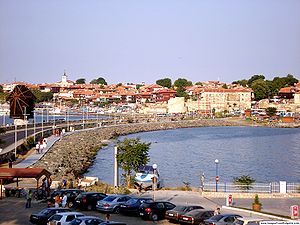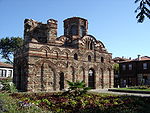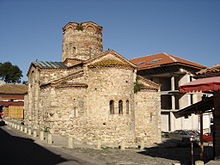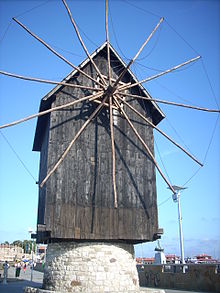- Nesebar
-
Ancient City of Nessebar * UNESCO World Heritage Site
Country Bulgaria Type Cultural Criteria iii, iv Reference 217 Region ** Europe and North America Inscription history Inscription 1983 (7th Session) * Name as inscribed on World Heritage List
** Region as classified by UNESCONesebar (Bulgarian: Несебър, pronounced [nɛˈsɛbɐr], also transcribed as Nessebar or Nesebur; ancient name: Menebria and Mesembria) is an ancient town and one of the major seaside resorts on the Bulgarian Black Sea Coast, located in Burgas Province. It is the administrative centre of the homonymous Nesebar Municipality. Often referred to as the "Pearl of the Black Sea" and "Bulgaria's Dubrovnik", Nesebar is a rich city-museum defined by more than three millennia of ever-changing history.
It is a one of the most prominent tourist destinations and seaports on the Black Sea, in what has become a popular area with several large resorts—the largest, Sunny Beach, is situated immediately to the north of Nesebar.
Nesebar has on several occasions found itself on the frontier of a threatened empire, and as such it is a town with a rich history. The ancient part of the town is situated on a peninsula (previously an island) connected to the mainland by a narrow man-made isthmus, and it bears evidence of occupation by a variety of different civilisations over the course of its existence. Its abundance of historic buildings prompted UNESCO to include Nesebar in its list of World Heritage Sites in 1983.
As of December 2009, the town has a population of 11,626 inhabitants.[1] It lies at 42°39′N 27°44′E / 42.65°N 27.733°ECoordinates: 42°39′N 27°44′E / 42.65°N 27.733°E.
Contents
Name
Inhabited in the Antiquity by the Thracians and the Ancient Greeks, the original Thracian settlement Menebria was called Mesembria (Ancient Greek: Μεσήμβρια) by the Ancient Greeks. Under this name it was still known in the Middle Ages to Bulgarians and Byzantines.
History
Antiquity
Originally a Thracian settlement known as Menebria, the town became a Greek colony when settled by Dorians from Megara at the beginning of the 6th century BC, and was an important trading centre from then on and a rival of Apollonia (Sozopol). It remained the only Doric colony along the Black Sea coast, as the rest were typical Ionic colonies. At 425-424 BC the town joined the Delian League, under the leadership of Athens.[2] Remains from the Hellenistic period include the acropolis, a temple of Apollo, and an agora. A wall which formed part of the fortifications can still be seen on the north side of the peninsula. Bronze and silver coins were minted in the city since the 5th century BC and gold coins since the 3rd century BC. The town fell under Roman rule in 71 BC, yet continued to enjoy privileges such as the right to mint its own coinage.
Medieval era
It was one of the most important strongholds of the Byzantine Empire from the 5th century AD onwards, and was fought over by Byzantines and Bulgarians, being captured and incorporated in the lands of the First Bulgarian Empire in 812 by Khan Krum after a two week siege only to be ceded back to Byzantium by Knyaz Boris I in 864 and reconquered by his son Tsar Simeon the Great. During the time of the Second Bulgarian Empire it was also contested by Bulgarian and Byzantine forces and enjoyed particular prosperity under Bulgarian tsar Ivan Alexander (1331–1371) until it was conquered by Crusaders led by Amadeus VI, Count of Savoy in 1366. The Bulgarian version of the name, Nesebar or Mesebar, has been attested since the 11th century.
Monuments from the Middle Ages include the 5–6th century Stara Mitropoliya ("old bishopric"; also St Sophia), a basilica without a transept; the 10th century church of the Virgin; and the 11th century Nova Mitropoliya ("new bishopric"; also St Stephen) which continued to be embellished until the 18th century. In the 13th and 14th century a remarkable series of churches were built: St Theodore, St Paraskeva, St Michael St Gabriel, and St John Aliturgetos.
Ottoman rule
The capture of the town by the Turks in 1453 marked the start of its decline, but its architectural heritage remained and was enriched in the 19th century by the construction of wooden houses in style typical for the Bulgarian Black Sea Coast during this period. At the early 19th century many locals joined the Greek patriotic organization Filiki Eteria, while at the outbreak of the Greek War of Independence (1821) part of the town's youth participated in the struggle under Alexandros Ypsilantis.[3]
Nesebar was a kaza centre in İslimye sanjak of Edirne Province before 1878.[4]
Third Bulgarian state
After the Liberation of Bulgaria from Ottoman rule in 1878, Nesebar became part of the autonomous Ottoman province of Eastern Rumelia as a kaza centre in Burgaz sanjak until it united with the Principality of Bulgaria in 1885. Around the end of the 19th century Nesebar was a small town of Greek fishermen and vinegrowers. In the early 20th century, the total population increased to 1,870.[3] It developed as a key Bulgarian seaside resort since the beginning of the 20th century. After 1925 a new town part was built and the historic Old Town was restored.
Churches
Nesebar is sometimes said to be the town with the highest number of churches per capita.[1], [2] Today, a total of forty churches survive, wholly or partly, in the vicinity of the town.[3] Some of the most famous include:
- the Church of St Sophia or the Old Bishopric (Stara Mitropoliya) (5th–6th century)
- the Basilica of the Holy Mother of God Eleusa (6th century)
- the Church of John the Baptist (11th century)
- the Church of St Stephen or the New Bishopric (Nova Mitropoliya) (11th century; reconstructed in the 16th–18th century)
- the Church of St Theodore (13th century)
- the Church of St Paraskevi (13th–14th century)
- the Church of the Holy Archangels Michael and Gabriel (13th–14th century)
- the Church of Christ Pantocrator (13th–14th century)
- the Church of St John Aliturgetos (14th century)
- the Church of St Spas (17th century)
- the Church of St Clement (17th century)
Whether built during the Byzantine, Bulgarian or Ottoman rule of the city, the churches of Nesebar represent the rich architectural heritage of the Eastern Orthodox world and illustrate the gradual development from Early Christian basilicas to medieval cross-domed churches.
Honour
Nesebar Gap on Livingston Island in the South Shetland Islands, Antarctica is named after Nesebar.
Gallery
References
- ^ (English) Bulgarian National Statistical Institute - towns in 2009
- ^ Petropoulos, Ilias. "Mesembria (Antiquity)". Εγκυκλοπαίδεια Μείζονος Ελληνισμού, Εύξεινος Πόντος. http://www.ehw.gr/blacksea/Forms/fLemmaBodyExtended.aspx?lemmaID=11229. Retrieved 8 June 2011.
- ^ a b c Doncheva, Svetlana. "Mesimvria (Nesebar)". Εγκυκλοπαίδεια Μείζονος Ελληνισμού, Εύξεινος Πόντος. http://www.ehw.gr/blacksea/Forms/fLemmaBodyExtended.aspx?lemmaID=11561. Retrieved 8 June 2011.
- ^ http://acikarsiv.ankara.edu.tr/fulltext/3066.pdf
- Evaluation of the International Council on Monuments and Sites, June 1983 (PDF file)
External links
- Gallery of pictures from Nesebar
- Folklore Ensemble Slanchev Bryag – Nessebar
- Ancient Nesebar
- Portal of Nessebar
Boyana Church · Madara Rider · Nesebar (Nessebar) · Pirin National Park · Rila Monastery · Rock-hewn Churches of Ivanovo · Srebarna Nature Reserve · Thracian Tomb of Kazanlak · Thracian Tomb of Sveshtari
Capital Nesebar
Towns Villages Banya · Gyulyovtsa · Emona · Koznitsa · Kosharitsa, Orizare · Panitsovo · Priseltsi · Ravda · Rakovskovo · TankovoLandmarks Hagia Sophia Church · Church of Saint John the Baptist · Church of St Stephen · Church of St Paraskevi · Church of the Holy Archangels Michael and Gabriel · Church of Christ Pantocrator · Church of St John Aliturgetos · Church of St Theodore
Nesebar Archaeological Museum · Irakli · Cape Emine · Slanchev BryagBulgarian Black Sea resorts Dobrujan Black Sea coast
(Northern coast, Dobrich Province)Moesian Black Sea coast
(Central coast, Varna Province)Asparuhovo · Briz · Byala · Chaika · Chernomorets · Golden Sands · Emona · Euxinograd · Fichoza · Galata · Irakli (Burgas Province) · Kabakum · Kamchia (resort) · Kara Dere · Luna · Obzor (Burgas Province) · Pasha Dere · Prostor · Rakitnika · Rai · Riviera · Romantika · Constantine and Helena · Shkorpilovtsi · Sunny Day · Trakata · Varna
Thracian Black Sea coast
(Southern coast, Burgas Province)Agalina · Alepu · Aheloy · Ahtopol · Arapia · Arkutino · Atia · Begliktash · Burgas · Chernomorets · Chervenka · Dyuni · Evropa · Gradina · Kavatsite · Kiten · Kolokita · Koral · Kosharitsa · Kraimorie · Lazurno More · Lozenets · Nesebar · Nestinarka · Perla · Pomorie · Primorsko · Raiski Zaliv · Ravda · Rezovo · Robinzon · Ropotamo · Sarafovo · Silistar · Sinemorets · Smokinya · Sozopol · Sunny Beach · St. Anastasia Island · St. Cyricus Island · St. Ivan Island · Stomoplo · St. Peter Island · St. Thomas Island · Sveti Vlas · Tsarevo · Veselie · Varvara · Zlatna Ribka
Categories:- World Heritage Sites in Bulgaria
- Nesebar
- Populated places established in the 2nd millennium BC
- Populated places in Bulgaria
- Bulgarian Black Sea Coast
- Ancient Greek sites in Bulgaria
- Ancient Greek cities
- Burgas Province
- Populated coastal places in Bulgaria
Wikimedia Foundation. 2010.


















